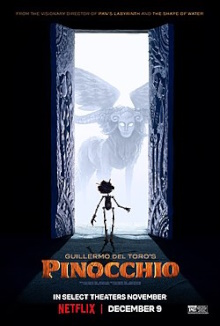Like most people I watched Disney’s version long ago but I don’t remember much of it. I do remember enough to tell that this version is different in many ways and as far as I’m concerned, they’re all good changes. As we’ve come to expect from Guillermo del Toro, it’s darker in tone and I loved Pinocchio looks like a crude, unvarnished wooden puppet. It seems that del Toro was inspired by one particular artist’s, Gris Grimly, illustrations. Instead of taking place in a fantasy version of Europe, this is set in World War 2-era Italy. Most importantly, whereas the original was all about telling children to be good and to be obedient towards their parents, this version subverts that lesson to have Pinocchio learn and decide what it means to be good on his own.
Despite losing his wife early on, woodcarver Geppetto enjoys life with his son Carlo in a small town in Italy. When Carlo is killed by a stray bomb during the First World War, Geppetto is devastated. One night, in a fit of drunkenness, he chops down the pine tree that was grown to honor his memory and carves the wood into a puppet. The spirits notice Geppetto’s grief and a wood sprite brings the puppet to life, naming him Pinocchio. A cricket who wanted to make the tree his home protests, so the sprite offers him a wish in exchange for being Pinocchio’s moral guide. Geppetto at first reacts with horror as the puppet wrecks destruction his house, being unable to tell right from wrong and finding delight in everything. The townsfolk are fearful and the Podestà who runs the town insists that he be sent to school. But then the carnival owner Count Volpe and his pet monkey Spazzatura notice Pinocchio and realize the potential of using him in their show. They tempt Pinocchio into performing for them and running away from home.
One of my favorite things about this film is how free it feels to be anything it wants to be, disregarding expectations about format. Pinocchio first shows up fifteen minutes into the film, allowing plenty of time to develop the character of Geppetto and his relationship with Carlo. Though in many ways this feels like Disney musical, it doesn’t feel obligated to give every character a song or make sure that a musical number occurs every once in a while according to a set formula. It isn’t afraid to show characters definitively dying on screen and I even love how it has a proper epilogue, giving each character a proper sendoff. The stop motion animation looks great and there’s even a sense of surrealism when all the characters react to Pinocchio being a living puppet, yet to us they are all indeed puppets. The dark tones and physical puppets accentuate the horror in a way that pure animation can’t achieve.
Yet the best reason to watch this is that it updates the moral lessons of old. Pinocchio is taught not to lie and to be good just as before, but both Geppetto and Sebastian J. Cricket turn out to be imperfect teachers. They flounder when Pinocchio asks them to justify and explain their rules. It’s not just Count Volpe who lies to and misleads Pinocchio, there’s also the Podestà and even Benito Mussolini himself who represents evil authority figures. As part of growing up, Pinocchio learns to think and to decide for himself what is right and wrong. One symbolically important scene even has him lying for a good cause. This is far more nuanced take on what it means to be good than simply obeying your elders. Finally, just as I would expect of del Toro, Pinocchio remains a puppet throughout, and a rather crude and eerie looking one, rather than anything sanitized and cute. You can see why the townsfolk would react to him with horror and why the Podestà would think to use him as a soldier.
As far as I’m concerned, this is pretty much one adaptation that is superior to the original classic in every way. It looks better, it captures the intense grief of a father losing his child and it’s an intelligent update on what lessons children should learn. I’d recommend it highly.
